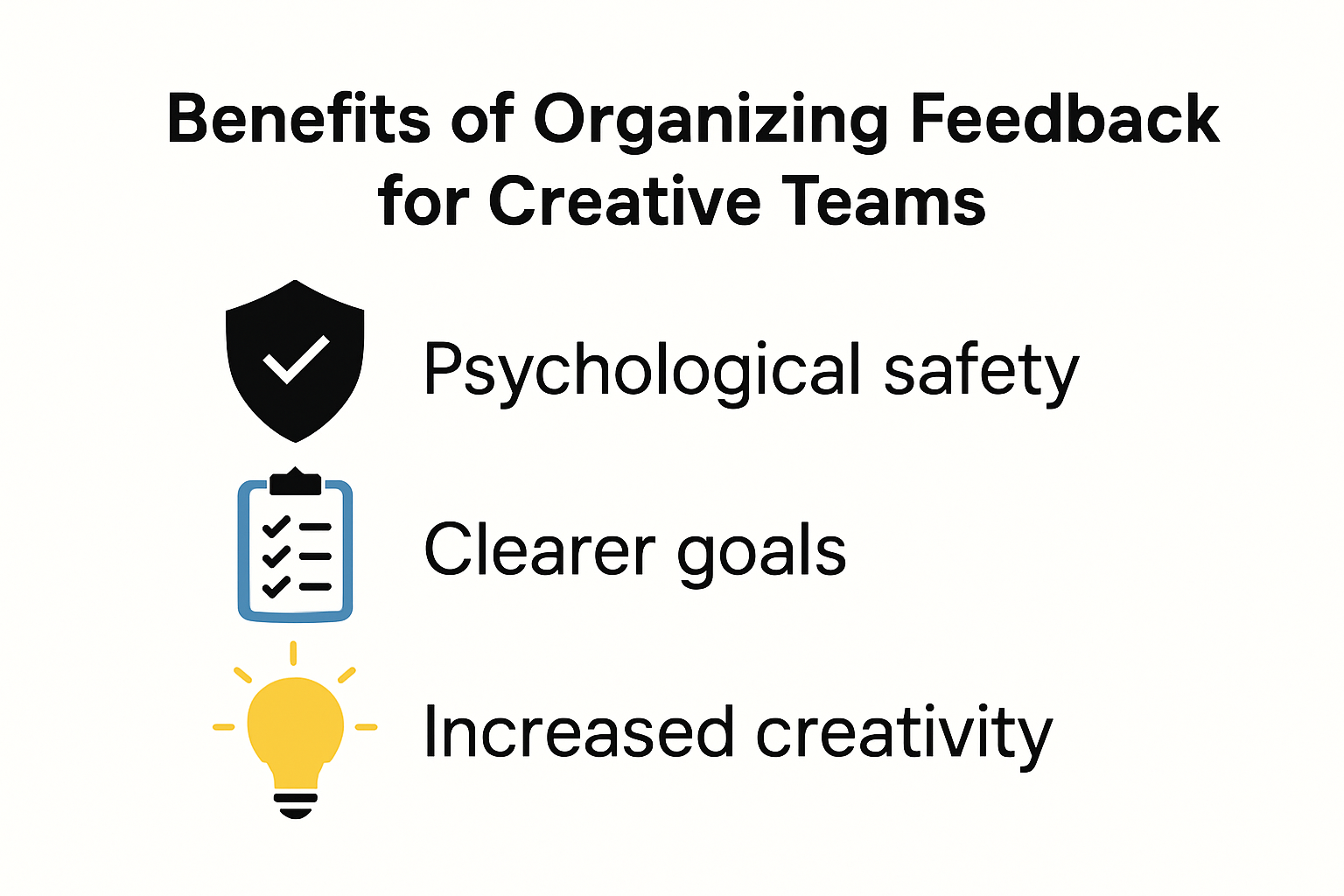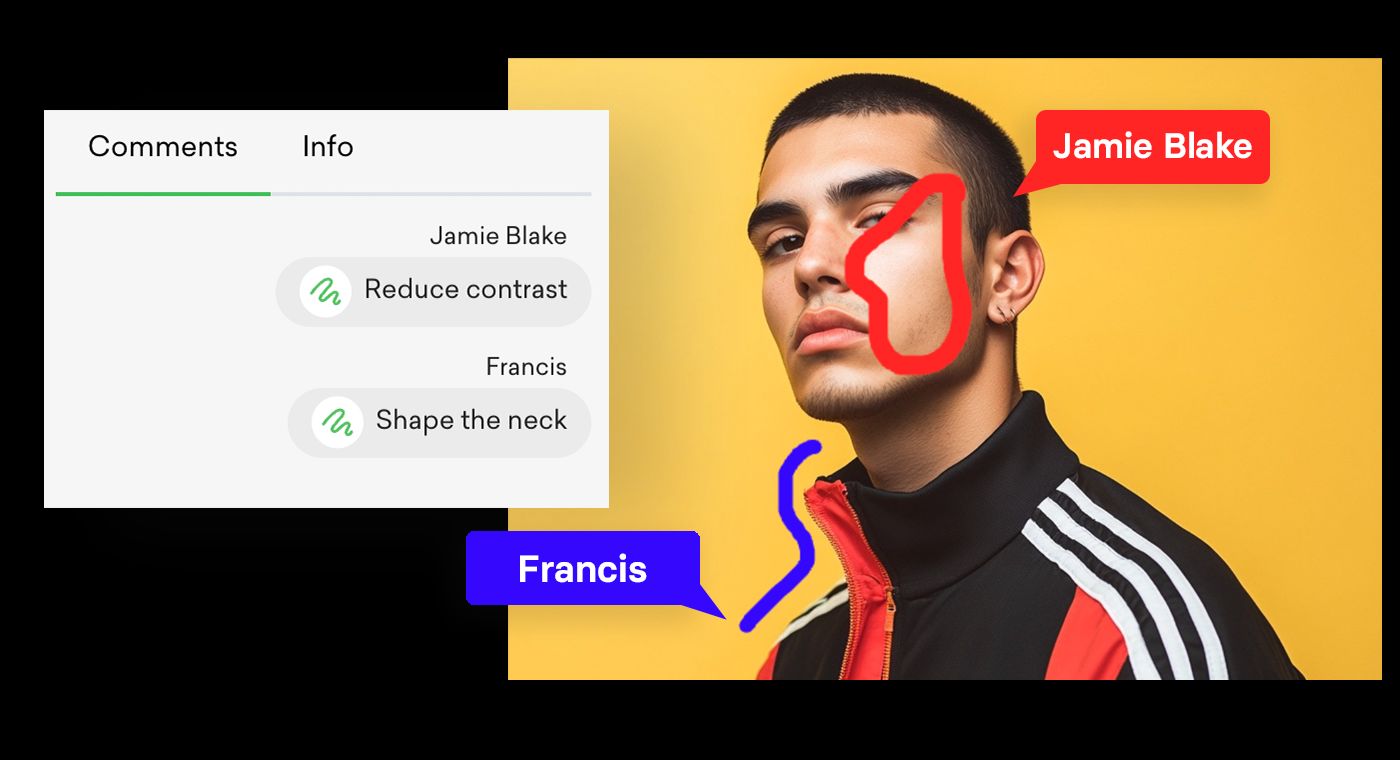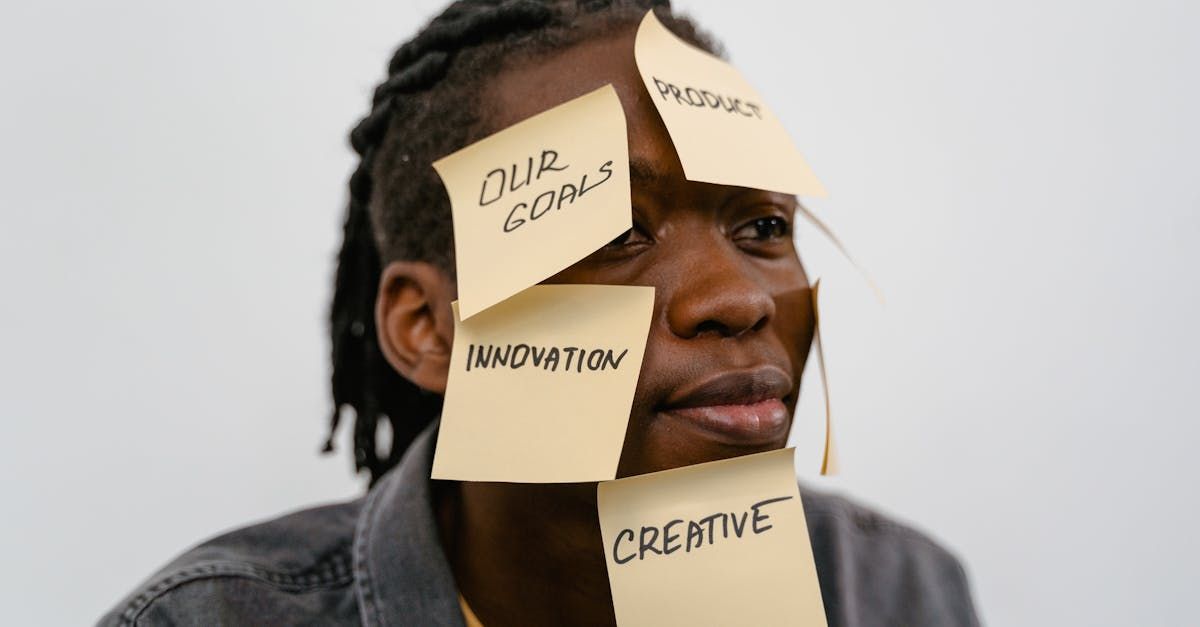Creative teams hear a lot about feedback, but it rarely feels easy to organize or act on it. Studies show teams with structured feedback processes actually see a measurable increase in creativity and project success. You might expect feedback to slow things down with endless opinions piling up. What actually happens is the exact opposite. The right organization turns feedback from a headache into the main source of creative breakthroughs.
Table of Contents
- Why Organizing Feedback Matters For Creatives
- Best Tools To Collect And Sort Creative Feedback
- Step-By-Step Guide To Streamlining Feedback Workflow
- Tips For Managing Feedback Across Multiple Projects
Quick Summary
| Takeaway | Explanation |
|---|---|
| Organized feedback enhances creative performance | A supportive feedback environment reduces uncertainty and improves goal alignment in creative teams. |
| Constructive critique drives innovation | Structured feedback transforms criticism into growth opportunities, fostering continuous improvement and professional development. |
| Implement clear feedback parameters | Defining project goals and standards beforehand minimizes ambiguity and ensures focused reviews for better outcomes. |
| Use specialized tools for feedback management | Selecting the right digital platforms facilitates effective communication and collaboration, enhancing feedback quality and project success. |
| Centralize feedback across projects | Establishing a unified system helps track feedback efficiently, preventing miscommunication and ensuring all inputs are addressed. |
Why Organizing Feedback Matters for Creatives
Creative professionals operate in an environment where communication and collaboration are critical to success. Organizing feedback is not just a administrative task but a fundamental strategy that can make or break project outcomes and team dynamics.
The Psychological Impact of Structured Feedback
Feedback represents more than simple critique. Research from psychological studies reveals that a supportive feedback environment significantly influences creative performance. When creative teams receive well-organized feedback, they experience enhanced goal internalization and reduced workplace uncertainty.
A supportive feedback mechanism does more than point out areas of improvement. It creates a psychological safety net where team members feel comfortable exploring innovative ideas without fear of harsh criticism. Organizational research indicates that environments encouraging feedback-seeking behavior directly correlate with improved creative output.

Transforming Critique into Creative Fuel
Effective feedback organization transforms potential criticism into constructive dialogue. For creative professionals, this means turning potential points of friction into opportunities for growth and innovation. When feedback is systematically collected, categorized, and communicated, it becomes a powerful tool for professional development.
The key lies in creating a feedback framework that is transparent, respectful, and actionable. This approach helps creative teams move beyond defensive reactions and embrace continuous improvement. Structured feedback allows team members to:
- Understand precise improvement areas
- Track progress over time
- Align individual efforts with team objectives
Building a Culture of Continuous Improvement
Workplace studies demonstrate that high-quality, credible feedback environments directly impact employee creativity. By establishing clear feedback mechanisms, organizations can reduce workplace ambiguity and create an atmosphere of trust and open communication.
The most successful creative teams view feedback not as a judgment, but as a collaborative process of refinement. This perspective shifts feedback from a potentially threatening experience to an exciting opportunity for professional growth and collective achievement.
Organizing feedback is ultimately about creating a communication ecosystem where creativity can flourish. It requires intentional design, consistent implementation, and a commitment to mutual respect and professional development.
Best Tools to Collect and Sort Creative Feedback
In the dynamic world of creative work, having the right tools to collect and organize feedback can dramatically transform team collaboration and project outcomes. While numerous solutions exist, selecting the most effective tools requires understanding specific team needs and workflow dynamics.
Digital Collaboration Platforms
Modern creative teams require sophisticated platforms that go beyond simple comment threads. Research exploring online collaboration systems highlights the importance of tools that can interleave discussion and summarization, enabling more nuanced feedback collection.
Key features to consider in digital collaboration platforms include:
- Real-time commenting capabilities
- Version control and tracking
- Permissions management
- Visual annotation tools
These platforms allow creative professionals to provide precise, contextual feedback directly on project files, reducing miscommunication and streamlining review processes.

Communication and Feedback Integration Tools
Research on communication systems demonstrates the critical role of tone and clarity in feedback delivery. Advanced tools now offer intelligent features that help teams maintain professional and constructive communication.
Intelligent feedback tools can help creative teams:
- Analyze communication tone
- Provide structured feedback templates
- Track feedback history
- Generate actionable insights
By integrating communication analysis with feedback mechanisms, these tools help prevent misunderstandings and promote more effective collaboration.
Specialized Creative Feedback Solutions
The most effective feedback tools are those specifically designed for creative workflows. These solutions understand the unique challenges faced by designers, photographers, and content creators.
Ideal creative feedback tools should offer:
- High-resolution file support
- Seamless markup and annotation
- Client and team collaboration features
- Secure sharing mechanisms
When selecting a feedback tool, creative teams must prioritize platforms that not only collect input but also facilitate meaningful dialogue and continuous improvement. The right tool transforms feedback from a potential source of friction into a powerful catalyst for innovation and creative growth.
To help readers compare the three major categories of feedback tools, the following table summarizes their core features and strengths:
Efficiently compare the main types of feedback tools and their unique features for creative teams:
| Tool Type | Key Features | Strengths |
|---|---|---|
| Digital Collaboration Platforms | Real-time comments, version control, annotation | Contextual feedback, streamlined review process |
| Communication & Feedback Integration Tools | Tone analysis, feedback templates, history tracking | Structured, clear communication, actionable insights |
| Specialized Creative Feedback Solutions | High-res support, markup, secure sharing, collaboration | Tailored for creatives, precise and visual feedback |
Step-by-Step Guide to Streamlining Feedback Workflow
Creative teams require a systematic approach to manage feedback effectively. A well-structured workflow ensures that input is captured, processed, and implemented efficiently, minimizing confusion and maximizing creative potential.
Establishing Clear Feedback Parameters
Research from workflow optimization experts highlights the importance of setting clear objectives before initiating any feedback process. This means defining specific goals, expectations, and evaluation criteria before team members begin reviewing work.
Key elements of establishing feedback parameters include:
- Defining precise project objectives
- Creating standardized evaluation criteria
- Setting realistic review timelines
- Identifying key decision makers
By establishing these parameters upfront, creative teams can reduce ambiguity and create a more focused review environment.
Implementing a Structured Review Process
Workflow management research demonstrates that structured reviews dramatically improve project outcomes. The review process should follow a systematic approach that breaks down complex feedback into manageable stages.
A recommended review workflow typically involves:
- Initial concept presentation
- Preliminary feedback collection
- Revision and refinement
- Final approval stage
Creative workflow experts recommend centralizing information and ensuring feedback remains specific and actionable throughout these stages.
For clarity, the step-by-step review process described above is summarized in this process table:
This table outlines the key stages of an effective structured feedback review process for creative teams:
| Review Stage | Description |
|---|---|
| Initial Concept Presentation | Share project concept with team/stakeholders |
| Preliminary Feedback Collection | Gather first-round input and suggestions |
| Revision and Refinement | Implement changes based on feedback; iterate |
| Final Approval Stage | Confirm all changes; obtain final sign-off |
Optimizing Communication and Follow-up
Effective feedback workflows are built on transparent and timely communication. After collecting feedback, teams must have a clear mechanism for tracking, implementing, and confirming changes.
Critical communication practices include:
- Documenting all feedback comprehensively
- Assigning clear responsibilities for implementing changes
- Setting concrete deadlines for revisions
- Confirming completion of requested modifications
Successful creative teams view the feedback workflow as a collaborative journey. By establishing clear parameters, implementing structured reviews, and maintaining open communication, teams can transform feedback from a potential source of tension into a powerful tool for collective creativity and continuous improvement.
Tips for Managing Feedback Across Multiple Projects
Managing feedback across multiple creative projects simultaneously requires strategic planning, robust communication systems, and adaptive techniques that prevent information overload and maintain project momentum.
Developing a Centralized Feedback Management System
Research on communication mapping demonstrates the critical importance of structured information flows in preventing project delays and miscommunication. Creative teams must implement a centralized system that allows seamless tracking and management of feedback across different projects.
Key components of an effective centralized feedback management system include:
- Unified feedback repository
- Cross-project tagging mechanisms
- Priority and status tracking
- Automated notification systems
By creating a single source of truth, teams can reduce communication friction and ensure no critical feedback falls through the cracks.
Leveraging Crowd and Collaborative Feedback Strategies
Innovative studies on creative work systems reveal the potential of crowd feedback in enhancing creative processes. Modern creative teams can expand their feedback collection by incorporating diverse perspectives and distributed input.
Strategies for effective crowd and collaborative feedback include:
- Implementing peer review mechanisms
- Creating cross-functional feedback panels
- Utilizing external expert consultations
- Developing structured feedback templates
These approaches help teams gather comprehensive insights while maintaining project-specific focus and quality standards.
Optimizing Feedback Prioritization and Implementation
Research on reflective system development highlights the importance of strategic feedback management. Creative teams must develop robust frameworks for evaluating, prioritizing, and implementing feedback across multiple concurrent projects.
Effective feedback prioritization involves:
- Establishing clear project hierarchies
- Creating weighted feedback evaluation criteria
- Developing rapid response protocols
- Implementing periodic feedback review sessions
Successful multiple project feedback management is not about handling every input equally, but about creating intelligent systems that distinguish between transformative suggestions and minor commentary.
Ultimately, managing feedback across multiple projects requires a holistic approach that balances systematic processes with creative flexibility. Teams that master this balance can turn feedback from a potential administrative burden into a powerful driver of innovation and continuous improvement.
Frequently Asked Questions
What are the benefits of organizing feedback for creative teams?
Organizing feedback enhances creativity, improves project success, and fosters a supportive environment where team members feel comfortable sharing ideas without fear of harsh criticism.
How can we transform criticism into constructive feedback?
By creating a structured feedback framework that is transparent, respectful, and actionable, teams can turn potential points of friction into opportunities for growth and improvement.
What tools can help collect and manage creative feedback effectively?
Digital collaboration platforms, communication and feedback integration tools, and specialized creative feedback solutions are essential for efficient feedback collection and management.
How can we manage feedback across multiple creative projects?
Developing a centralized feedback management system, leveraging crowd and collaborative feedback strategies, and optimizing feedback prioritization and implementation are key strategies to effectively manage feedback across multiple projects.
Elevate Creative Feedback with Pikd: The Platform Built for You
Are you tired of disorganized feedback, lost file versions, and endless email threads hindering your creative process? The article highlighted how structured feedback and a centralized system are vital for creative teams to move from confusion to real innovation. Pikd solves these exact pain points with a visual-first platform that brings order and clarity to creative reviews. Instead of scattered commentary and generic folders, you get real-time feedback, precise permissions, and beautiful galleries that strengthen both your workflow and client relationships.

Stop letting valuable insights slip through the cracks. Experience for yourself how easy it is to upload, organize, and collaborate on high-resolution work through Pikd. Visit our main site now to start organizing your feedback in a way that drives true creative growth. Your next breakthrough might be one streamlined review away.

































